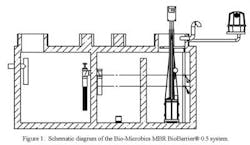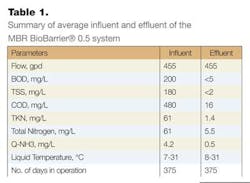The term membrane bioreactor (MBR) describes a combination of a biological process and membrane separation. The MBR forms an important advancement in the treatment of wastewaters. In comparison with conventional treatment techniques, MBR technology displays several advantages, such as very high effluent quality, limited space requirements and possibilities for a flexible and phased extension of the treatment plant.
With conventional methods - such as single-family septic systems - only 10 to 40 percent of treatment occurs in the tank. If this untreated wastewater enters groundwater or waterways, it can cause a potential health hazard to the community. Conversely, advanced wastewater treatment systems, such as an MBR, can perform up to 99.9 percent of the treatment directly in the tank.
Generally, treatment of residential wastewater by the MBR system would produce effluent with non-detectable TSS, BOD concentration of less than 2 mg/L, ammonia-nitrogen concentration of less than 0.5 mg/L, fecal coliform count of less than 20 per 100 mL and, with proper design, total nitrogen concentration of less than 5 mg/L. The MBR effluent can easily be considered for reuse in various applications. The MBR system is also ideal for treating challenging wastewaters, such as low temperature conditions and compounds that are difficult to treat.
Other Considerations for MBR Systems
Over the last 15 years, MBR technology has extensively been applied to treat both municipal and industrial wastewaters. Currently, there are more than 2,000 small and large (56 MGD) MBR treatment plants in operation in the world.
For owners, there are a number of key factors to consider when contemplating selection of an MBR system. For one, capital costs for a typical MBR system have become more competitive. In many cases, the cost of an MBR is less than the cost of a conventional tertiary system for reuse. However, the cost of an MBR is marginally more expensive than a system designed to achieve only secondary effluent quality. Small MBR systems that are designed for on-site applications can also compete economically with secondary treatment technology when consistent nitrogen and phosphorus removal is required or the wastewater is biologically difficult to treat.
It is well documented that MBR systems are more energy intensive than their conventional treatment equivalents largely due to the energy required for membrane air scour. Significant gains in energy efficiency have been achieved in the last decade, however. This is a major area of research and development. With currently available technology for wastewater screening, pretreatment and membrane cleaning, the predicted life of membrane elements is about seven years, and their associated costs need to be considered in any present worth analysis.
The BioBarrier® MBR utilizes flat sheet membranes for a versatile design and robust process in wastewater recycling. Engineered in a small footprint and immersed directly in the aeration process, the BioBarrier has a high surface area of membrane material in a double-plate configuration. Treated water moves through the pores to the space between the films; a pump then extracts the clean water to discharge into the environment. BioBarrier removes pollutants, along with E. coli and fecal coliform, without add-on disinfection.
Bio-Microbics uses third-party certifiers like the National Sanitation Foundation International (NSF), an accredited American Standards National Institute (ANSI) organization in the U.S., as well as other certifiers (marine and land-based) in Europe, Canada, New Zealand, etc., to market its products and systems. BioBarrier MBR, since 2010, is the only system with NSF/ANSI 350 certification for water reuse. The NSF/ANSI Standard 350 combines Standard 40, Standard 245 and Water Quality Standards to meet applicable levels of treatment with onsite systems for environmental safety, nitrogen reduction and water reuse safety for interior/exterior usage (e.g., backflow for toilets; lawn, landscape and green area irrigation; building water processes; machine wash water).
The BioBarrier system met the treatment level requirement without additional disinfection; however, this does depend on local regulations. The Standard 350 certification "assures that the water is treated to a safe level for specific non-potable reuse applications, like surface or subsurface irrigation, toilet/urinal flushing, decorative fountains, etc. This applies to any technology type capable of meeting the requirements without limitations on system design or treatment capacity."
"Certification NSF/ANSI 350 positions onsite water reuse technologies as a viable solution to increasingly overburdened water and wastewater treatment facilities, water scarcity and increasing costs associated with energy and water uses," said Tom Bruursema, NSF Sustainability. "Innovative clean technology manufacturers can now demonstrate the acceptability and effectiveness of their product."
With the suspended aeration outside of the MBR module, the solids have more retention time in the tank to break down. The aerobic bacteria consume the lesser bacteria, viruses and organic material. Further, the membrane's pore size is down to .03 micron, making it suitable for even direct discharge with no disinfection.
Because membrane systems are highly automated processes, redundancy and reliability need to be evaluated through the design process. There are many approaches to building redundancy into an MBR process. These include specification of redundant trains, influent equalization (relevant for smaller facilities), stand-by power, and hot back-up PLCs. The level of redundancy required is site specific, and the available storage, overall number of process trains, reliability of power, and type of plant (end of pipe vs. water reuse facility) should be considered.
For successful implementation of MBR technology in decentralized applications, it is important to recognize some of the limitations of the conventional design approaches that are used successfully for large-flow MBR applications. The small flow systems of decentralized applications provide unique design opportunities and challenges for a reliable and robust MBR system. A reliable, acceptable and successful decentralized MBR treatment system should:
- Be able to operate without a need for operators for an extended period of time
- Have reliable, small, electromechanical equipment, such as blowers, pumps and valves that do not require routine maintenance
- Have a reliable screening system (highly recommended)
- Have a control system that can handle potential variations of the quality of the power source; such variations are typical of remote sites
- Be cost effective in both capital and operational costs
- Have a biological system designed to minimize the frequency of sludge wasting
- Have a membrane system designed and operated to minimize the frequency of chemical cleaning of the membranes
- Be able to handle high daily or weekly flow and organic load variations associated with very small flow applications, such as single residential homes, churches, schools, and rest areas, effectively and without impairing treatment performance
Currently, there are several domestic and international equipment manufacturers that supply small MBR systems for the decentralized market.
Case Study
This case study presents the design and performance of a single-home MBR system supplied by Bio-Microbics, Inc. The MBR BioBarrier® 0.5 system is designed to handle a daily residential flow of 500 gpd or less.
Figure 1 shows a schematic diagram of the MBR BioBarrier system used in this study. The tank was a two-chamber, 1,100-gallon concrete septic tank.
The first chamber, with an effective liquid volume of 350 gallons, was used as the settling and screening tank. The screen, SaniTEE®, was placed in the outlet of the settling tank. The opening of the screen was 1/16" and proved to be ideal for this application.
The second chamber, with an effective liquid volume of 750 gallons, was used for the biological and membrane tank. The biological tank was divided into two equal zones with a patent-pending baffle wall. The first zone was the anoxic zone, and the second zone was the aeration/membrane zone.
The anoxic zone was equipped with a small submersible mixing pump. Settled and screened wastewater was introduced into this zone. The mixing pump provided mixing and transferring of nitrified mixed liquor from the aeration zone back to the anoxic zone via special ports in the baffle wall for the denitrification process.
One BioBarrier membrane module was installed in the third zone. The membrane module utilizes flat sheet membrane technology aeration for the biological process, and membrane operation was provided by a blower. The aeration grid was located under the membrane module housing.
The system utilizes two floats: one for various operational conditions of the membrane system, such as filtration mode or relaxation mode; the other is used to indicate high water level in the tank, serving as an alarm. The filtrate water is transferred from the top of the membrane module to the outside of the tank by a small submersible pump. All of the system's electromechanical devices are operated by a single board micro-processor. This control system allows the system to operate automatically.
The sewage was supplied by a retirement community in De Soto, Kan., that consisted of about 40 homes. A portion of the flow from the community was pumped to a storage tank as the feed source. The daily feeding procedure of NSF Standard 40 was used to feed the system. The morning feed was about 160 gallons, the noon feed was about 115 gallons and the evening feed was about 180 gallons. The duration of each feed was two hours.
Table 1 summarizes the characteristics of raw wastewater and the effluent quality obtained with the MBR BioBarrier 0.5 system during the study. Samples of the influent and effluent for analysis were collected once a week during the study. Values shown in Table 1 represent the average value for all samples collected and analyzed during the study. The duration of the study was 375 days.
ABOUT NSF/ANSI 350:Onsite Residential and Commercial Reuse Treatment Systems establishes criteria to improve awareness and acceptance of water reuse technologies that reduce impacts on the environment, municipal water and wastewater treatment facilities, and energy costs. According to the American Water Works Association, 84 percent of residential water is used in non-drinking (non-potable) water applications such as lawn irrigation, laundry and toilet flushing. Residential and commercial builders, architects and regulators are turning to onsite wastewater reuse systems as a solution to increasing water scarcity and energy costs associated with the treatment and distribution of municipal water and wastewater
Conclusion
- MBR technology provides the highest effluent quality at reasonable costs.
- MBR technology can effectively be used for decentralized applications.
- MBR technology is more effective in treating wastewaters that are challenging for conventional biological treatment systems.
- With an MBR system, the issue of sludge settleability is replaced by filterability of the sludge.





